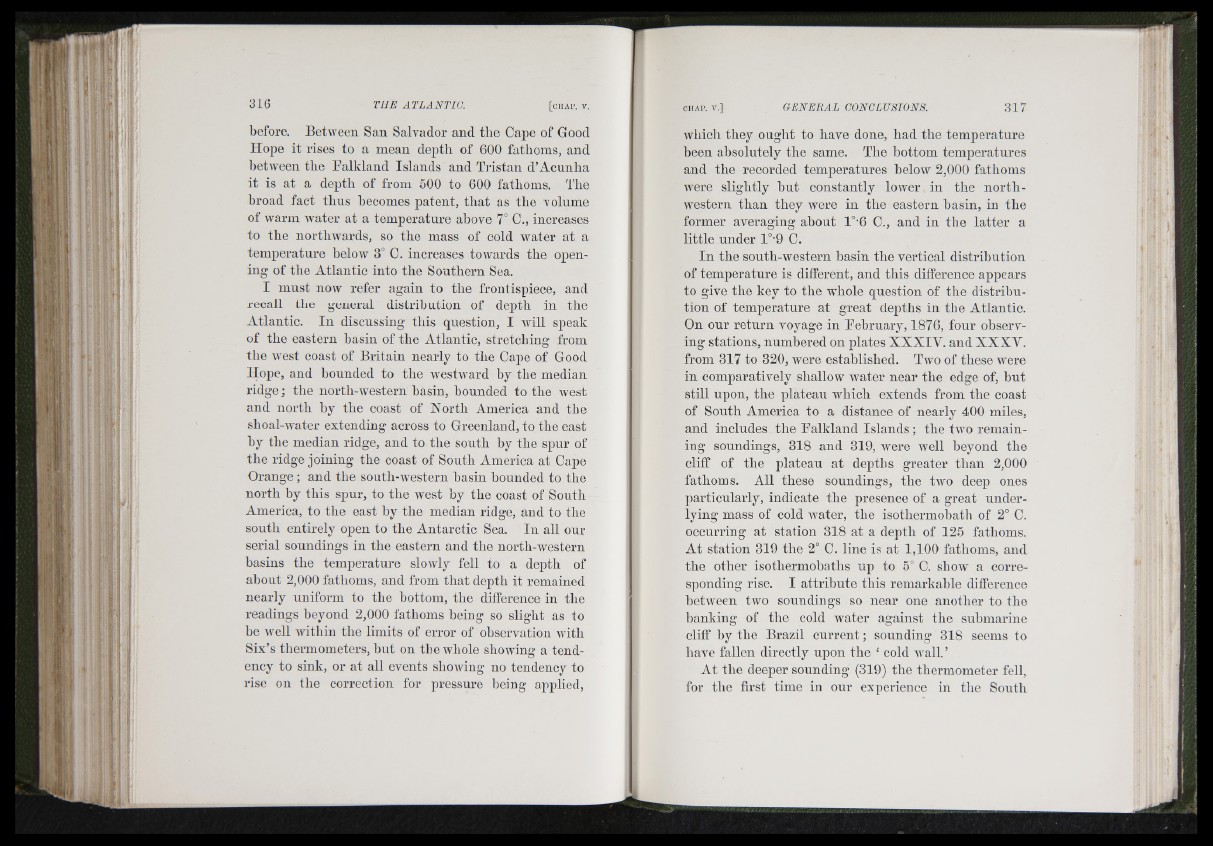
■V ]M ■■l'f
before. Between San Salvador and the Cape of Good
Hope it rises to a mean depth of 600 fathoms, and
between the Falkland Islands and Tristan d’Acunha
it is at a depth of from 500 to 600 fathoms. The
broad fact tbus becomes patent, tbat as tbe volnme
of warm water at a temperatnre above 7° C., increases
to tbe northwards, so the mass of cold water at a
temperatnre helow 3° C. increases toAvards the opening
of the Atlantic into the Sonthern Sea.
I mnst now refer again to the frontispiece, and
recall the general distribntion of deptb in tbe
Atlantic. In discnssing tbis qnestion, I Avill speak
of tbe eastern basin of tbe Atlantic,^ stretcbimO? from
tbe Avest coast of Britain nearly to the Cape of Good
Hope, and bounded to the AvestAvard by tbe median
ridge; tbe nortb-Avestern basin, bounded to tbe Avest
and north hy the coast of North America and tbe
sboahwater extending across to Greenland, to tbe east
by tbe median ridge, and to tbe south by the spur of
the ridge joining the coast of South America at Cape
Orange; and the sonth-AA'estern basin hounded to the
north by tbis spur, to tbe west by tbe coast of Soutb
America, to tbe east by tbe median ridge, and to tlie
soutb entirely open to tbe Antarctic Sea. In all our
serial soundings in tbe eastern and tbe nortb-AA'estern
basins tbe temperature slowly fell to a deptb of
abont 2,000 fathoms, and from that deptb it remained
nearly uniform to the bottom, the difference in tbe
readings beyond 2,000 fathoms being so slight as to
be AA'ell Avitbin the limits of error of observation Avitb
Six’s tbermometers, but on tbe whole showing a tendency
to sink, or at all events showing no tendency to
rise on tbe correction for pressure being applied.
which they ought to have done, had the temperatnre
heen absolutely the same. The hottom temperatures
and the recorded temperatures heloAV 2,000 fathoms
were slightly but constantly lower in the northwestern
than they were in the eastern basin, in the
former averaging ahout l°-6 C., and in the latter a
little under 1°'9 C.
In the south-western basin the vertical distribution
of temperature is different, and this difference appears
to give tbe key to tbe whole qnestion of tbe distribution
of temperature at great depths in tbe Atlantic.
On our return voyage in February, 1876, four observing
stations, numbered on plates XXXIV. and XXXV.
from 317 to 320, were established. Two of tbese Avere
in comparatively shallow water near the edge of, but
still upon, the plateau which extends from the coast
of South America to a distance of nearly 400 miles,
and includes the Falkland Islands ; the tAvo remaining
soundings, 318 and 319, Avere well beyond the
cliff of the plateau at depths greater tban 2,000
fathoms. All these soundings, the tAvo deep ones
particularly, indicate the presence of a great underlying
mass of cold AA'ater, tbe isothermobatb of 2° C.
occurring at station 318 at a depth of 125 fathoms.
At station 319 the 2° C. line is at 1,100 fathoms, and
the other isothermohaths up to 5° C. show a corresponding
rise. I attribute tbis remarkable difference
between two soundings so near one another to tbe
banking of tbe cold water against tbe submarine
cliff by tbe Brazil current ; sounding 318 seems to
have fallen directly upon tbe ‘ cold wall.’
At tbe deeper sounding (319) tbe thermometer fell,
for tbe ffrst time in onr experience in tbe Soutb